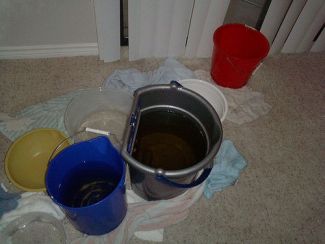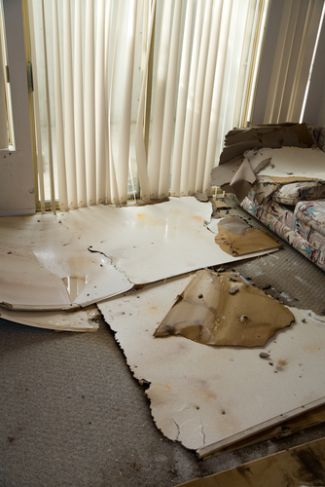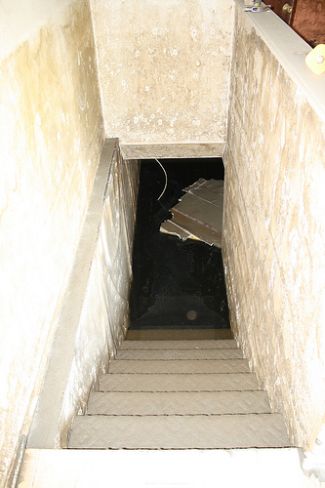Water Damage Cleanup, Part 2 - Fixing the Problem
Before beginning the water damage cleanup and repair process, make sure that it is safe for you to be in your home. Read about safety issues to consider when dealing with water damage in part 1 of this article.

Stop Incoming Water
Once you have determined that it is safe to begin cleanup, start by preventing additional water from entering your house. If pipes are leaking, turn your house's water supply off immediately. Have a plumber address the pipe leak. Similarly, if your roof is leaking, do your best to stop the leak and collect the water, and have a roofing professional fix your roof as soon as possible.
Take Pictures
While the damage is still evident, take pictures of all the water damaged areas in your home. These could prove important later on, as you deal with insurance companies or other parties. Be as complete as possible, but also do this quickly. It is important to begin cleanup as fast as you can.
Dry the Area, Circulate Fresh Air
 Speed and fresh air are important. You want to dry out your home as quickly as possible to reduce the chance of serious mold problems. Use a wet/dry vacuum to remove water from floors and furniture. Open your windows and use fans to circulate as much fresh air as you can through the water damaged area. Additionally, use dehumidifiers to remove moisture. Run the fans and dehumidifiers until the drying process has completely finished.
Speed and fresh air are important. You want to dry out your home as quickly as possible to reduce the chance of serious mold problems. Use a wet/dry vacuum to remove water from floors and furniture. Open your windows and use fans to circulate as much fresh air as you can through the water damaged area. Additionally, use dehumidifiers to remove moisture. Run the fans and dehumidifiers until the drying process has completely finished.
Carpet and Furniture
Remove wet carpet, as well as furniture and valuable items from water damaged rooms. Be careful not to bring waterlogged items into dry, undamaged rooms, in order to avoid spreading moisture or mildew.
If your carpet has only been wet for a day or two, you might be able to keep it, although the padding should be thrown away. First, remove water from the carpet with a wet/dry vacuum, and then clean it with a professional carpet cleaning machine. However, if the carpet has been waterlogged for more than a couple of days, you will probably need to discard it.
Walls, Ceilings, Floors
 Check your walls for signs of damage to the drywall. If your drywall is swollen or obviously waterlogged, it will have to be replaced. If your interior walls have undergone extreme water damage, cutting holes in them could help to speed the drying process. However, check with a water damage expert and your insurance company before you begin slicing away at your walls.
Check your walls for signs of damage to the drywall. If your drywall is swollen or obviously waterlogged, it will have to be replaced. If your interior walls have undergone extreme water damage, cutting holes in them could help to speed the drying process. However, check with a water damage expert and your insurance company before you begin slicing away at your walls.
If water leaked through ceilings or floors, you may need to replace items like ceiling tiles and flooring material. If your insulation has been soaked, it will lose its ability to insulate, so it will need to be replaced as well.
Standing Water
 Standing water can be especially tricky to deal with. If you have a lot of standing water in your basement, it is probably best to get an expert involved, because of counter-intuitive side effects that could result. For example, if a flood caused the standing water in your basement, the water-saturated soil outside could be exerting a lot of pressure on your basement walls. The standing water in your flooded basement, in this case, might actually be providing structural support to the walls. In extreme situations, pumping it out too quickly could cause your basement walls to crack or buckle.
Standing water can be especially tricky to deal with. If you have a lot of standing water in your basement, it is probably best to get an expert involved, because of counter-intuitive side effects that could result. For example, if a flood caused the standing water in your basement, the water-saturated soil outside could be exerting a lot of pressure on your basement walls. The standing water in your flooded basement, in this case, might actually be providing structural support to the walls. In extreme situations, pumping it out too quickly could cause your basement walls to crack or buckle.
After getting the standing water out of your basement, remove the remaining debris or mud before they dry. Finally, wash and sanitize the floor and walls.
Safety
Water damaged areas can be extremely dangerous, so error on the side of caution during the clean up process. Wear watertight gloves, clothing, and boots to protect yourself from bacteria, and only wade into standing water once you are absolutely sure that your electricity has been turned off. Finally, have someone else with you while you are working, in case of emergency. See our previous article for more on safety issues to consider when dealing with water damage.
Consider Using Professionals
Unfortunately, you may find that the scope of the damage is worse than you initially thought. If you discover signs of structural damage at any point, vacate the house immediately and contact professionals. Even if you are capable of handling the water damage clean up yourself, if you think it will take you a long time, consider using professional help, since fast and complete cleanup is the best way to reduce your chances of mold and mildew problems down the road. Finally, in your discussions with water damage professionals, ask for their opinions on preventative measures you can take, like a water powered sump pump or automatic water shut off valve, to help you avoid water damage in the future.
Image sources: globalreset and carlpenergy
 The Water Damage Cleanup, Part 2 - Fixing the Problem by Water Damage Defense, is licensed under a Creative Commons Attribution-ShareAlike 3.0 Unported License.
The Water Damage Cleanup, Part 2 - Fixing the Problem by Water Damage Defense, is licensed under a Creative Commons Attribution-ShareAlike 3.0 Unported License.
